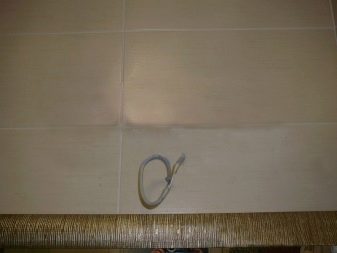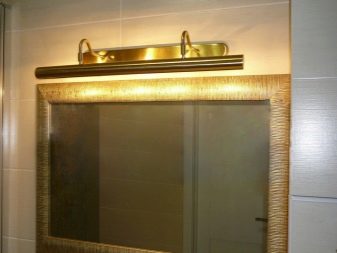Fixtures for the mirror in the bathroom
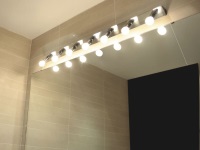
Why do you need it?
The bathroom room is one of the few places in the house where the sun's rays do not penetrate. In the absence of natural light, artificial light sources are especially important. The ceiling lamp is often the only light fixture in the bathroom. This is certainly economical, but not very convenient. The best option is to have two lights - the main one and an additional one.
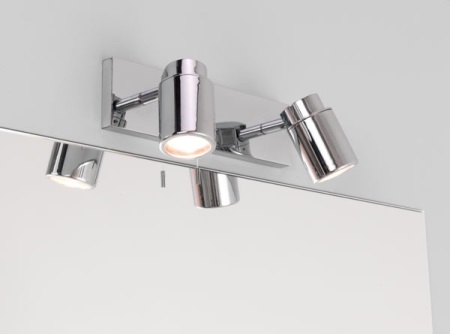
An additional lamp is often installed next to the mirror. In this place, the device can perform several functions at once:
- The lamp for the mirror will provide the necessary illumination for daily cosmetic and hygienic procedures (shaving, makeup application, etc.);
- If you want to relax and spend some time in the semi-darkness (for example, taking a bath), the mirror lamp will be a source of soft soft dim light;
- At night time mirror fixture can be a source of light for the bathroom.

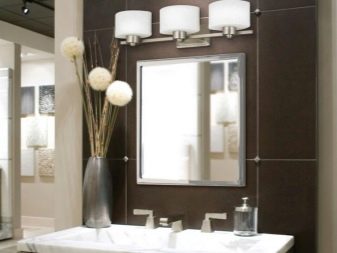
Illuminance Characteristics
The mirror in the bathroom is a kind of working area, where building the right lighting plays a big role. There are a few basic rules for illuminating a bathroom mirror:
- The fixtures should be positioned so that the light illuminates the entire work surface, while at the same time not getting into the eyes.
- When the main lighting job and the mirror fixture work simultaneously, the most even lighting should be created, with no interfering shadows.
- Most artificial light sources distort colors. If you are used to make up at the mirror in the bathroom, then buy for the lamp bulbs, the light of which by color spectrum is closest to the natural one.
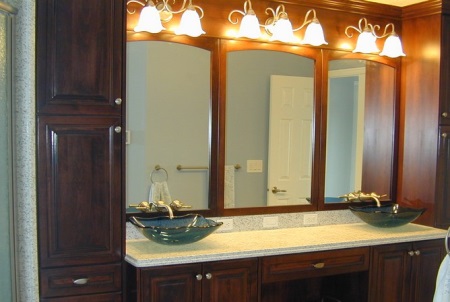
Types
There are several options for organizing the lighting of the working area in the bathroom.
Wall
Bra is a traditional lighting fixture that can be installed in any room of the house, regardless of its purpose - in the hallway, kitchen, bedroom, etc. For the bathroom, there are special moisture-proof wall lights that can be used in conditions of high humidity. Sconces create diffused soft light, so the fixtures of this type are loved by those for whom the bathroom is an area of solitude and relaxation.
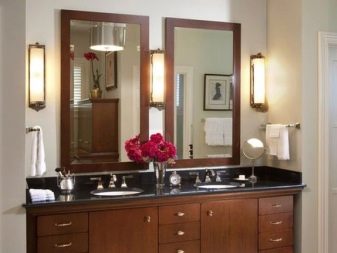
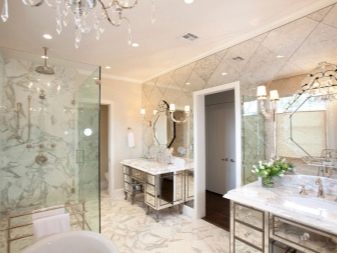
Mirrors with built-in lighting
A novelty on the market of bathroom equipment such interior items can not be called a novelty, but still they are not yet widespread. There are a lot of variants of combination of a mirror and a lamp, and they all look very impressive. A mirror with built-in lighting will be the main decoration of your bathroom. Built-in lighting frees up space that would have been reserved for wall lights - and that's one of its main advantages.
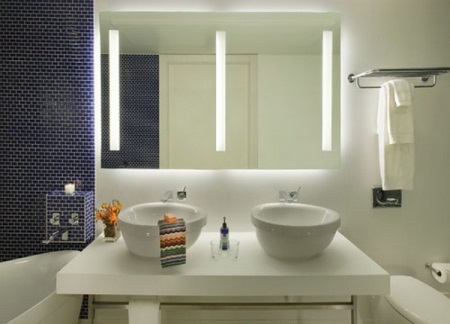
LED spotlighting
LED bathroom lights can come in a variety of forms, whether wall-mounted, recessed, or strip lighting. In stores you can find LED lighting fixtures designed directly to illuminate mirrors (they are also used to illuminate pictures). Such fixtures create a smooth light, do not glare and do not distort the image.
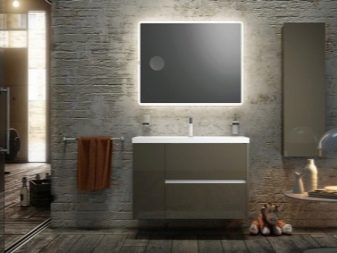
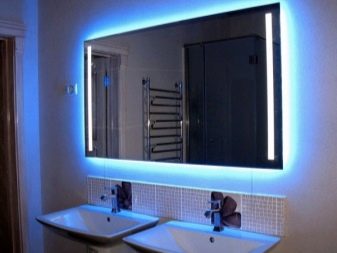
Led tape
LED strip is now actively used to organize the lighting of a variety of interior elements - stairs, paintings, podiums, decoration of facades, buildings, etc. Led-tape consists of LEDs with resistors, one of its sides are applied adhesive composition. To fix it near the mirror in the bathroom just cut the tape into pieces of appropriate size, remove the protective film and stick it in place. LED strip is very plastic and thin, which allows you to realize the most daring design fantasies. The only thing to consider is that it is poorly compatible with old electrical equipment.
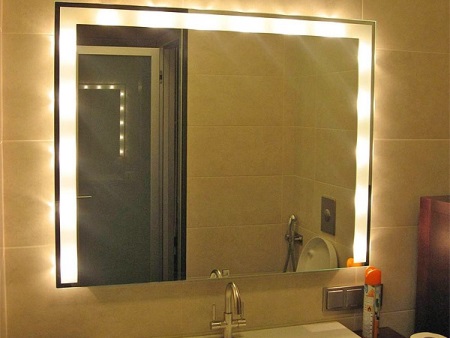
Advantages of LED lights
- LED bulbs can help you save money on your electric bill. They use significantly less energy than incandescent and modern energy-saving bulbs.
- Even though LED bulbs use less power than other types of lighting fixtures, the level of light they create is just as good.
- The service life of LED lights is very long. They cost more than incandescent bulbs, but they work dozens of times longer.
- LED bulbs are considered the most optimal for use in the bathroom, as they well tolerate temperature changes and high levels of humidity.
- LED bulbs are available in a variety of colors, which is sure to please fans of experimenting with lighting.
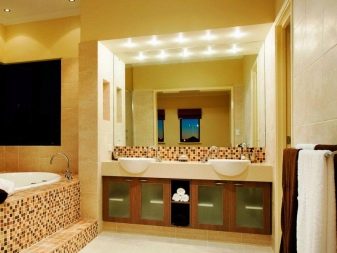
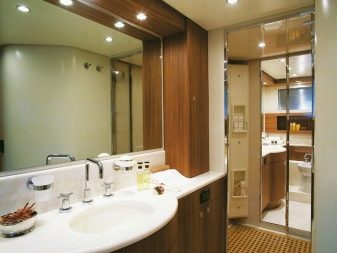
Placement
There are two options for the location of lighting fixtures near the mirror. Each of them has its own advantages and disadvantages.
Above the mirror
This arrangement of the lamp is the most advantageous in terms of saving space. The space above the mirror is usually left free, while cabinets and shelves for hygiene items can be hung on the sides of the mirror. The disadvantage of this arrangement of the light source is that the light, falling from above, illuminates all the defects of the skin. Of course, the practical harm it does not bring, but the mood in the morning can spoil pretty badly.
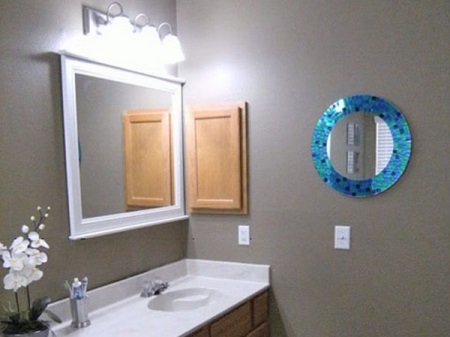
On the side of the mirror
Lights on either side of the mirror create a lighting effect, as close as possible to natural, daylight. That is why, for women who prefer to apply makeup in front of the mirror in the bathroom, this arrangement of lighting fixtures is considered preferable. The disadvantage of this option is that the lights take up quite a lot of space on the wall. In addition, for uniform illumination of the mirror one side lamp is not enough, you need to install two. And this is twice the installation work.
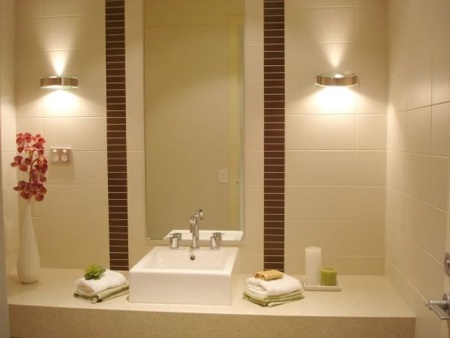
Tips for choosing
There are several determining factors that affect the choice of a light fixture for a mirror in the bathroom:
- The degree of protection against moisture. Only moisture-proof fixtures should be chosen for the bathroom. Whether or not the lighting fixture you choose is such is indicated on the packaging. IP abbreviation and two digits indicate the class of protection against moisture and dust belongs to the luminaire. Luminaire with at least IP 44 is suitable for use in the bathroom.
- Brightness. Both men and women use the mirror in the bathroom, first of all, to clean themselves. To ensure that the result of all hygienic and cosmetic manipulations did not turn out completely opposite to what was expected, it is necessary to ensure a sufficient degree of illumination of the room. The brightness of the light is measured in lux. If you add up the brightness of all light fixtures in the bathroom, the total should be at least 200 lux.
- Design. Determine the required technical characteristics of the bathroom mirror light is easy, but to choose a design is a much more difficult task. The lamp should be matched with the rest of the bathroom interior, including finishing materials, furniture and plumbing fixtures. The luminaire can be a bright accent in the interior or, on the contrary, not to attract attention. A huge selection of lighting fixtures, offered by construction hypermarkets and online stores, allows you to find what you need, even to the most demanding buyer.
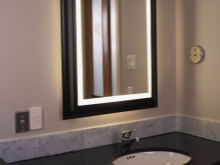

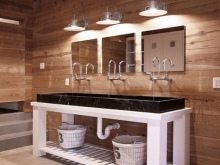
Installation
In this section, we will tell you about how to install a wall lamp for a mirror in the bathroom.
Determining the place of installation, you should take into account the height of each member of the family. Choose the position of the light fixture so that the face of the person looking into it is illuminated brightly and evenly. Installation of wall lights requires a hidden electrical wiring, going to the place where you want to hang the light fixture. To conduct concealed wiring is necessary to punch a hole in the wall, put wires in them, seal the hole with cement and disguise with ceramic tile or other finishing material. Usually this work is entrusted to professional electricians.
So, the sequence of installation:
- turn off the electricity in the bathroom;
- assemble the lighting fixture in accordance with the manual;
- Attach the body of the lamp to the wall and make a marking for the fasteners;
- according to the markings, drill holes in the wall;
- through the mounting holes, mount the luminaire to the wall;
- The power cable, coming from the wall, pass through the body of the luminaire and screw it to the terminal block;
- turn on the electricity and test the operation of the light fixture.
